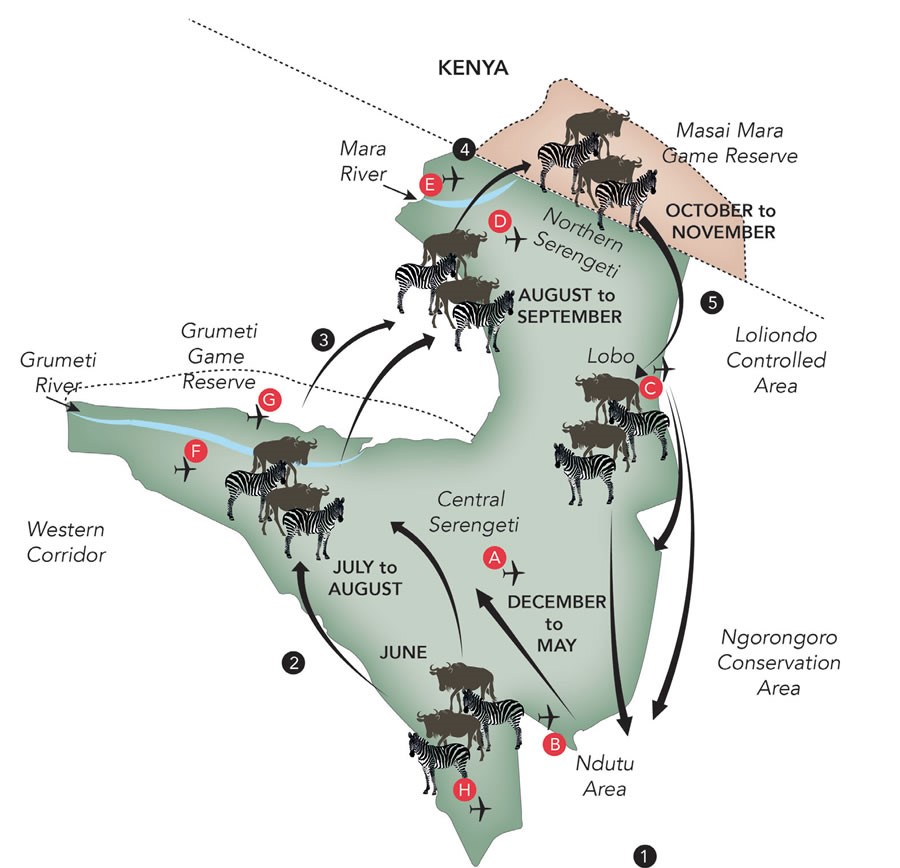- Arusha - Tanzania
- +255 787 555 700
The yearly migration of two million ungulates, primarily wildebeest, but also massive herds of zebra, Thomson’s gazelle, Grant’s gazelle, and eland, through Serengeti National Park is the biggest natural display of its kind in Africa, if not the world.
Although there are seasonal fluctuations, the Serengeti migration follows a fairly predictable yearly cycle influenced by local rainfall trends. The Great Migration cycle is divided into the following phases:

you probably want to include seeing the Great Migration. So how do you ensure to be there when it happens? The long and short of it is that you can’t. It is important to realize that the decision of when to visit the Serengeti always involves an element of risk. We have detailed the Great Migration below, and this is what usually happens, but keep in mind that there are no guarantees.
The annual migration of two million ungulates, wildebeest but also enormous groups of zebra and Thomson’s gazelle, Grant’s gazelle and eland. Serengeti National Park is the greatest wildlife spectacle of its type in Africa, and perhaps the world. Although variations occur from year to year, the Serengeti migration follows a reasonably predictable annual cycle, dictated by local rainfall patterns. The Great Migration cycle breaks up into the following periods:
We can find the main calving grounds in the area southeast of Seronera: Serengeti plains stretch all the way to the Ndutu area near Ngorongoro. Triggering their move to this area are the short rains in November and December. The wildebeest stick around this area until the end of the long rains, end of April, early May. The delightful news is that this section of Serengeti National Park is easily accessible and that in this period the landscape becomes lush.
February is usually calving season in the Ndutu area and the southeastern plains: the very best time to visit this area. As wildebeest, zebra and other ungulates are so many, and give birth to so many calves, the spectacle works as a magnet for predators. As early as March or April the herd may move again in search of greener pastures. Seeing the actual migration in this period is more difficult, but chances are that you will encounter very large herds on the move.
This is the period that the wildebeest, after having feasted on the short green grasses of the southeastern Serengeti and after having giving birth to their offspring, start getting ready for their 800 kilometer long trek. The actual starting date may be anytime between late April and early June.
This is the time to you may have the privilege to see one of the greatest natural phenomena in the world: more than a million marching animals in a column up to 40 kilometers long. During the migration, the herd will move towards the Western Corridor, where they will face the first major obstacle: crossing the Grumeti River. Many animals don’t survive the crossing as they are being awaited by the area’s population of oversized crocodiles ready to feast. The herd may congregate on the southern bank of the river and stay there for up to two weeks before crossing the river.
When the Grumeti River obstacle has been taken, the herd moves further north and starts crossing the next big hurdle, the Mara River, in July or August. The Mara River crossing is where so many iconic Great Migration photos have been taken. After this crossing the herd flocks to the northwest plains and Masai Mara National Reserve in Kenya. The August – September period is considered being a bad time to visit Serengeti National Park and see the Great Migration as the herd moves into the Masai Mara in Kenya.
However, migration patterns show that about half of the herd stays on the Tanzanian side, in the Mara Serengeti area. In this period, smaller herds of wildebeest (well consider small… herds may count up to between 500 and thousands of individuals) frequently cross the Mara River, back and forth, for no apparent reason. This is an excellent time to stay at one of the Serengeti Mara camps.
Crossing the Mara River northbound means that, at one point, the herd needs to cross the river one more time before commencing the trek back in a southerly direction. This usually happens in October, but sometimes earlier.
In this period the herd will cross the northern plains and Lobo area. This section of Serengeti National Park is little-visited, so if you are looking to see the migration in relative quietness, this would be the time. The wildebeest return to the short- grass plains and calving ground around Ndutu in late November. And from here, the Great Migration starts all over again.
As mentioned earlier, the timings outlined on this page concern guidelines as exceptions occur frequently. In November 2013, the wildebeest already started trekking back to the southern Serengeti short-grass plains when suddenly it started raining north of the Mara River.
Nature is as nature does and the herd turned around, back into the Masai Mara in Kenya. The herd stayed there for about three weeks before resuming their southbound journey. A year later, in 2014, freak rains in the southern Serengeti caused much of the herd to remain behind and not make the northbound journey towards the Western Corridor up to July.